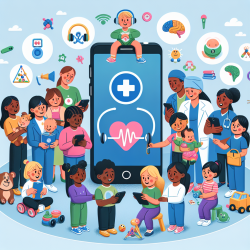Hearing loss is a prevalent developmental disorder that, if undetected, can negatively impact a child's speech, language, cognitive, educational, and socio-emotional development. This is especially concerning in low- and middle-income countries (LMICs), where more than 80% of children with hearing loss reside. A recent study titled Community-based hearing screening for young children using an mHealth service-delivery model explored the feasibility of using a smartphone-based hearing screening program for preschool children operated by community healthcare workers (CHWs) in South Africa.
Conducted over a 12-month period, the study involved training five CHWs to map early childhood development (ECD) centers and conduct hearing screenings using the hearScreen™ smartphone application. This innovative app employed automated test protocols on low-cost smartphones and featured cloud-based data management and referral functions for remote monitoring and follow-up.
The study screened 6,424 children aged 3 to 6 years, resulting in a 24.9% referral rate. However, only 39.4% of referred children attended their follow-up appointment at a local clinic. Logistic regression analysis indicated that age, gender, and environmental noise levels had significant effects on referral rates. Interestingly, the quality index reflecting the test operator's test quality increased over the first few months of testing.
Key Findings and Recommendations
- Feasibility: The study demonstrated that smartphone-based hearing screening can be effectively conducted by CHWs in community-based settings. This is particularly valuable in LMICs where access to specialized healthcare services is limited.
- Age and Gender: Younger children (3-4 years) showed higher referral rates, suggesting that older children (5-6 years) are more suitable candidates for such screenings. Additionally, females were found to be more likely to fail the screening compared to males.
- Environmental Noise: Active noise monitoring is crucial for accurate results. The study found that noise levels at 1 kHz significantly affected referral rates, indicating the need for stringent noise control measures during screenings.
- Follow-up Rates: The low follow-up rate (39.4%) is a concern. Strategies such as sending reminder texts and providing immediate onsite assessments could improve these rates.
The hearScreen™ application offers several advantages:
- Automated Test Protocols: These allow non-specialist personnel to conduct screenings, making it feasible to deploy in resource-limited settings.
- Cloud-Based Data Management: This feature enables remote monitoring and ensures data is securely stored and easily accessible for follow-up.
- Quality Control: The application includes quality indices for test operators, ensuring reliable results and guiding further training if needed.
For practitioners, implementing these findings can enhance the effectiveness of hearing screenings in community settings. By leveraging mHealth technologies, we can bridge the gap in early hearing detection and intervention services, particularly in underserved regions.
To read the original research paper, please follow this link: Community-based hearing screening for young children using an mHealth service-delivery model.










